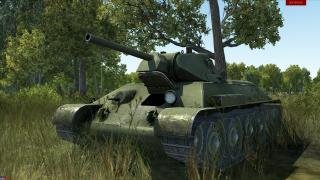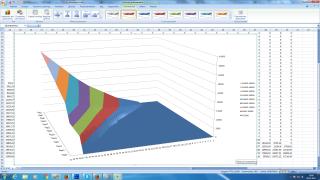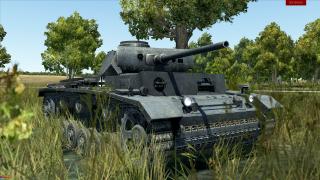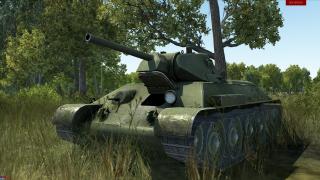Dev blog #113
12.11.2015

Hello everyone!
Today we want to share several IL-2 Sturmovik news with you.
First, we finished two-seat fighter Bf 110 E-2 flight model and start working on physics of another aircraft, Ju 88 A-4. Development of twin engine aircraft, all of which have sophisticated array of instruments, isn't easy, but we keep up as planned so far and think it will be ready on time. In parallel, its 3D model is being made, here are several WIP screenshots from 3D editor:
Second, while preparing playable tanks for the beta test, we made significant improvements to the ballistics and armor modeling, mainly improved interpolation of a damage inflicted between reference data values. Let's go in some detail ;) Since there is no universal formula that lets you calculate how much damage a round would deal after piercing a certain armor sheet knowing its impact speed and angle, we use reference data (like it pierced 54 mm at 30 degrees) and sometimes additional reference points calculated using the empiric De Marre formula. Between these points you need to interpolate the results (like how much would it pierce at 34 degrees and at higher speed). Optimization is also needs to be taken into account, since one 12.7 bullet can impact dozens of various systems and parts after entering an aircraft. Problem was, armor penetration was right when close to reference points described above, but its interpolation between them was rather rough (usually resulting in higher armor penetration values). However we found a way to improve the 2D 'speed-armor-damage' interp
Third, we observe the discussion 'how far can you reach from the cockpit in the flight' on the forums for a long time and obviously the current implementation is not satisfactory for the community. It is clearly a very subjective since it depends on whether a pilot tied his safety belts or not, how much can he endure the wind blasting at his head and body while keeping the ability to see anything, does he wear a mask and many other things, but we decided to make a more universal approach. Previously we calculated the air pressure force that forced pilot's head back into cockpit (it started to effect the pilot roughly at 300 km/h, reaching maximum effect at 500 km/h), but now we made it a bit more detailed:
0 - 50 km/h: you can stand up and lean your body outside (50 cm to the sides and 20 cm up, as it was before). This may be useful for taxiing.
50 - 100 km/h: you get back into cockpit, it's like you tighten your seat belts.
100 - 200 km/h: you can peek your eye a bit to look what's going on.
200 - 300 km/h: gradually you lose the ability to lean out completely.
Above 300 km/h you have the same head limits like in a closed cockpit.
For a bit of fun and first-hand demonstration, we made an experiment to learn how far you can lean to the side without moving the lower part of your body, the result you can see on the picture below. It depends on your height and general weight, but:
1) If cockpit sides are not too high (WWI era planes), you can easily lean up to 40 cm to the sides;
2) If a cockpit is narrow and its sides are on the level of your shoulders, it's difficult to lean more than 20 cm to the sides;
3) You need to watch your weight (compare the head size of our PM Han to head size of pilot model used in the game) :)
And the fourth thing today is the one we've been asked about many times. Player controllable tanks. Now there is a small story that consists of different parts.
Part 1. How did they appear in the first place
Tanks in our engine appeared even before we committed to Battle of Stalingrad project as a demonstration of its capabilities for simulating various machines. A tech demo has been created to showcase this, including a sophisticated (especially for that time) physics modeling engine for ground vehicles. Modern tanks were chosen for this demo and you may have saw it already since we published it in the developer diaries, but here it is in case you've missed it:
We found that developing this in our engine has great potential; at the same time we considered the possibilities of increasing map detail at the cost of reducing its total size to better suit ground warfare and the results were good as well. All in all, it was a very interesting experience and we learned how we can use the engine for different tasks. After that, we started Battle of Stalingrad and the work on ground warfare prototype has been suspended until the base of IL-2 sim has been released.
Some time ago it turned out that we have a spare time in 3D modeling department (there is usually a fine balance between the tasks of 3D and Engineer departments which works on FM, but creating FM takes more time, so sometimes 3D modelers have spare time) and we decided to use this opportunity to try player controlled ground vehicles in Battle of Stalingrad. High detailed 3D models of T-34-76 made by Stalingrad tank factory and PzKpfw III Ausf. L were created. The technology has been upgraded somewhat as well to make handling and damage modeling more realistic, since in the modern tanks prototype shown above a more casual approach has been used. At the moment, controllable tanks are in beta state and will be added to the game in 1.105 if everything goes well.
Part 2. Degree of realism and handling
Base engine lets us to create reasonably realistic tanks. At this stage, everything has been tuned to correspond to the references. Here are some highlights:
1) Engine and suspension. Engine physics model, transmission, tracks/ground friction, movement modeling - all these things are modeled at the same level of fidelity our planes are, resulting in believable tank behavior during its movement, reached speeds, acceleration and braking, turning and gradeability limits.
2) In spite of the advanced physics model, tank movement can be controlled with just 4 cursor keys or a joystick thanks to control system that translates these limited signals to forces applied to gas, clutch and brake pedals, gearbox selector and steering clutch levers (it's like driving a vehicle with a robotic gearbox).
3) Armament: main gun and coaxial MG for now. Ballistics, armor piercing capabilities, rate of fire - all such things were modeled with the same detail level as for a plane. There are two types of shells currently modeled: AP and HE.
4) Armor model includes all main armor sheets placed at correct angles.
5) Tank is considered destroyed when ammo racks are hit. It can also be immobilized by damaging engine or tracks and the crew can be knocked out.
6) You can control a tank either single-handedly (switching between driver and gunner) or with another player who will occupy gunner seat.
7) Gun sights are modeled to a reasonable degree of realism, including their field of view, authentic reticle marks, sight adjusting (vertical for both tanks, T-34 sight also has the horizontal adjustment ability), correct optics. At this stage, gunner sight can be considered minimally adequate.
Part 3. What we want to achieve and the future possibilities
You may have noticed that modeled tank systems are reasonably realistic, however not everything has been created yet (although there are some things not to be found in other recent projects about tanks). This can be explained by what we want from adding the tanks to our sim.
We made basic functionality to show potential possibilities of controllable tanks in our project and understand the player reaction to them. Mainly, would you like them? We demonstrate our approach (realism over balance, cooperative play in one vehicle, detailed systems modeling) in some kind of a Kickstarter-esque manner. If the existing community and new players would like the new toys, we'll assign more resources to improve and expand on the basis we have now, adding new systems, more detailed damage modeling, other features, and new vehicles.







